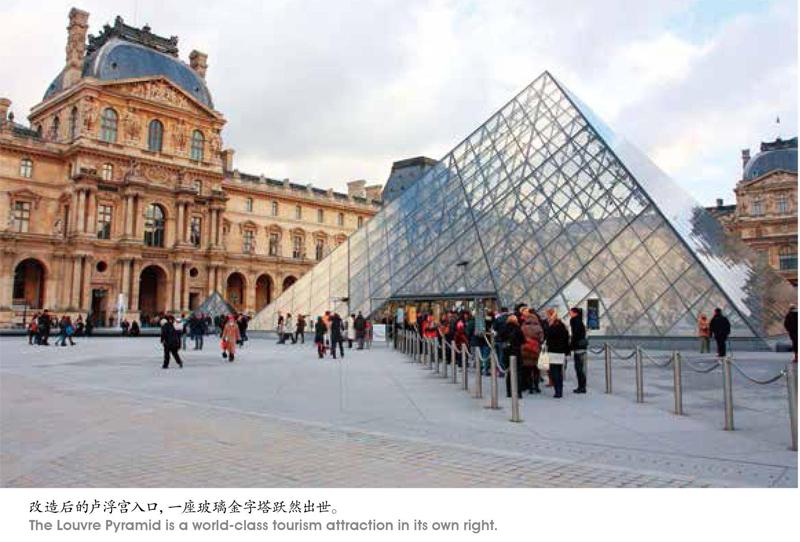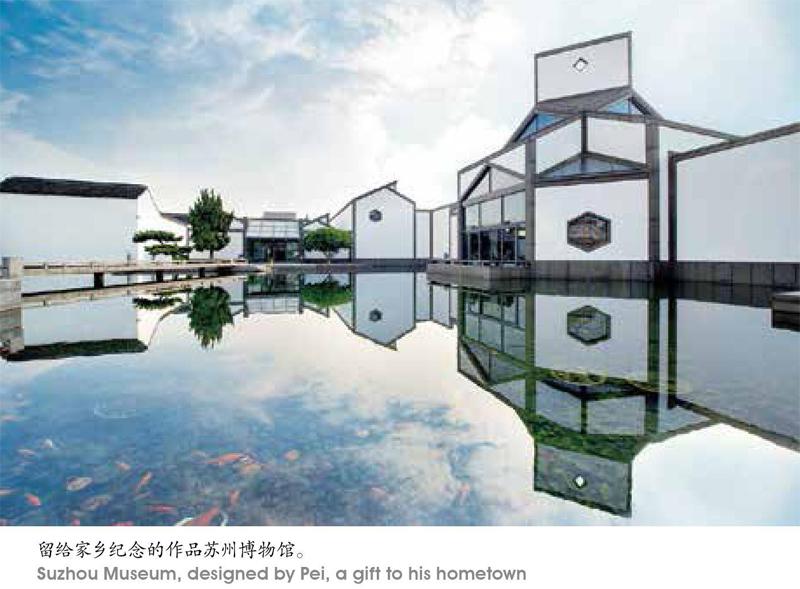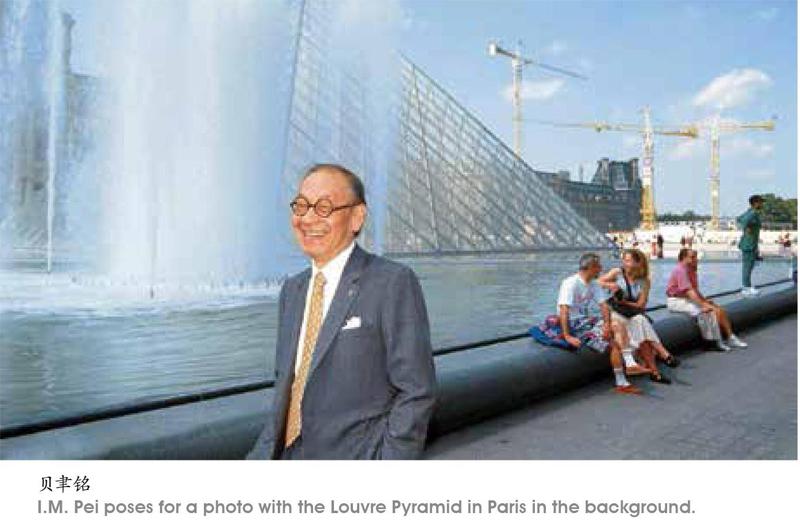“金字塔风波”使他誉满全球
2018-05-09孙国维
孙国维

1981年5月10日傍晚,弗朗素瓦·密特朗在大选中赢得了总统宝座,整个巴黎立即欢腾。密特朗在先贤祠的台阶上信誓旦旦要兑现竞选时的承诺,掀起现代法国轰轰烈烈的建筑高潮。在接下来的10年中,他要对巴黎进行大刀阔斧的改造,从中世纪的迷宫中切割出一条宽阔的大街,然后对陈旧不堪的卢浮宫作全新的修复。为此他要物色一位堪当重任的设计师。他经过深思熟虑,决定聘任在建筑界名扬四海的贝聿铭作为首席。一来,这位美籍华人来自中国,华夏文明举世瞩目;二来,贝聿铭两年前在为美国华盛顿特区的国家艺术馆设计建造的东楼引起世界轰动。同时,他提出的有关办公楼建筑群的方案也打动了密特朗。这个方案将使位于卢浮宫——凯旋门中轴线西端的德方斯街边缘地区的像曼哈顿一般的高层建筑趋于规范化。
一开始,贝聿铭拿到改造卢浮宫项目几乎十拿九稳。然而,后来拿到这个项目的却是一位在政府部门找到关系的法国建筑师。
真是好事多磨。在贝聿铭的建筑艺术生涯中尚未遇到这种使他感觉丢人的事,尤其是卢浮宫的改造工程确实是一项最让人觊觎的传世工程,贝聿铭正需要这样的公共舞台来彰显他的实力并确保他在建筑界的名誉和地位。他那雷打不动的自信和从不服输的精神,让他通过旅居巴黎的大画家赵无极引见密特朗总统。现任卢浮宫修复工程的掌门人、前文化部长比欧西尼在拉费尔饭店安排了贝聿铭同密特朗的会见。在这次会见之前贝聿铭做足了功课,他先后4次来到巴黎,在卢浮宫内外反复迂回探察,精心研究了法国最伟大的园林建筑师安德莱·勒诺特尔的作品,一张以金字塔作为入口的卢浮宫改造图跃然纸上。
会见中,贝聿铭向密特朗总统提出的卢浮宫修复工程的方案是:建造一座在理论上每小时容纳15000人,高度为70英尺的玻璃金字塔。以吉萨的古埃及金字塔为基础,周围配上三个“小金字塔”和三个有喷泉的清澈可鉴的三角形水池。它的好处是这种“通体透明的结构符号”可以作为避免丑化卢浮宫的一种富有创造性的方式。因为很难想象其他一种固体扩建部分能够和已经被岁月的长河磨损得黯淡无光的旧皇宫浑然一体。而建立在高科技材料基础上的古代建筑形式与老式建筑可以相得益彰。它可以和协和广场上的凯旋门、方尖碑以及香榭丽舍大街上的旅游景点一起显露风采并与原来就有的金字塔广场遥相呼应。这样,修整一新的卢浮宫将成为世界上最大最美的博物馆。密特朗对贝聿铭的方案满口赞同,并当场聘任他为这座法国古典文物的设计改造者。
谁知,这个聘任消息刚出爱丽舍宫就在法国各地引起轩然大波。尤其是建筑界和文艺界的一些人,他们把贝聿铭称之为不请自来的“第三者、插足者”。他们认为,卢浮宫是法国乃至整个欧洲的文化殿堂,聘用一个纽约人来整修国宝级文物岂不等于开门揖盗,拱手让具有“文化帝国主义”行径的美国染指法国文明。认为这件事本身就太具讽刺意味。密特朗和贝聿铭的结合似乎是“一种危险的联合”。一场围绕金字塔风波的大辩论席卷整个巴黎。其领军人物大都是些历史学家和政客。于是,“巴黎不要金字塔”和“不许干涉卢浮宫”的口号甚嚣尘上。
1984年年初,贝聿铭将改造修复卢浮宫的设计图案正式递交给“法国历史文物最高委员会”时,醒目的金字塔图像立即引起了这帮老爷们的愤怒和惊愕。委员会的前任主任建筑师贝特昂大声谴责说:“它超越了我们的思维空间”。
简直是个“庞大的毁灭性装置”。许多关心卢浮宫命运的巴黎市民也纷纷参加了这场反对金字塔的大合唱。客观上使修复卢浮宫的工程成为了一个众所瞩目的全民爱护文物运动。当人们得知,贝聿铭将要用一座不伦不类的金字塔来玷污神圣的拿破仑庭院和卢浮宫时,感觉简直是蒙受了奇耻大辱。狂怒的人群对于贝聿铭已经到了忍无可忍的地步,以致使他的翻译难以平静地为他做口译。有时,在街上还有人会对他信口吐槽。
所幸的是,64岁的贝聿铭毕竟是个阅尽人间春色的老练建筑艺术家,他的作品遍布全球,在业界具有不可动摇的地位。对于那些褒奖和非议他早已闻之若素。更何况他有密特朗总统信誓旦旦的承诺。那个“历史文物最高委员会”对于政府没有约束力。预定的修复计划如期进行,财政部的办公人员不得不遵照命令撤出由他们占据的厢房以便扩大展品陈列室。随着工程的顺利进展,卢浮宫已大大改观。游客的参观通道和陈列室以及便民设施都有彻底的改进。不论是入场口、参观通道还是自助餐厅和卫生间以及陈列室都可以极大地满足每年750多万的游客。17000件文物珍品中的一部分可以从暗无天日的地下室進入新的陈列室。参观者再也不必在狭隘的门口犹豫徘徊,他们可以由明亮宽敞的金字塔通道直奔主题前往瞻仰三大镇馆之宝——米洛维纳斯、胜利女神和蒙娜丽莎。
1988年3月4日,密特朗总统在宏伟工程竣工的金字塔内举行典礼,并授予贝聿铭荣誉勋章。因为金字塔已然成了密特朗东山再起的象征。那天大约有2000多显赫人物抱着先睹为快的心情,排队等候进入金字塔,以便零距离接触这座震惊世界的建筑壮举。在600盏灯光的聚焦下,乐队高奏《欢乐颂》,7座喷泉喷射出五光十色的水柱,把金字塔照得晶莹剔透。这一阵,人们对金字塔的狂热崇拜居然令作为法国标志的埃菲尔铁塔黯然失色。这一场景使一度备受冷落和打击的贝聿铭大有被“平反昭雪”的感慨。他对记者说:“我一直在等待着这一刻的来临!”
这位闻名全球的现代主义建筑大师贝聿铭,1917年出生,祖籍是中国苏州的一个名门望族,父亲是中国银行的创始人贝祖怡。他17岁留学美国,先后在麻省理工学院和哈佛大学攻读建筑学。毕业后先是跟随美国知名的都市改造营建商齐肯多夫工作,1955年他自立门户创办贝聿铭建筑事务所,在全球先后承包50多个项目。其著名作品包括美国华盛顿国家美术馆东馆、肯尼迪总统图书馆、加拿大皇家商业银行、新加坡华侨银行中心和双塔楼以及来福中心、希腊雅典现代艺术博物馆、日本美秀博物馆、卢森堡现代美术馆、中国香港的中国银行大厦、北京的中国银行总行大厦和香山饭店。2002年他回到故乡苏州设计了具有江南水乡韵味的苏州博物馆,作为炎黄子孙对家乡的回报。
貝聿铭的童年在苏州狮子林度过,那里的园林建筑在他的记忆中形成不可磨灭的印象,10岁那年去了上海。沿着外滩黄浦江边的那些高楼大厦引起他的关注。他想,在自己的国土上为何都让外国人来造房子?我们自己为何不能?在他幼小的心灵中埋下了火种,立志要在建筑事业上作出一番贡献。长大后,他一贯以严谨的态度和大胆的风格进行设计,特别善于运用几何图形,把古代传统建筑艺术与现代最新技术巧妙地糅合在一起,从而创造出自己的独特风格。他常说:“一所建筑物的形状应该使人得到感情上的满足”。
贝聿铭认为时间、地点和文化是建筑设计的要素。而以人为本是他必须坚持的原则,这也是中西方文化的差异所在。他认为在建筑设计中人的比例一定要放在头等重要的位置,设计之前必须深入了解当地的气候、自然和风土人情,这样才能“身临其境”。早年,他在设计建造落基山国际大气研究中心时,曾带上露营帐篷到接近沙漠的野地住了几天,体验当地的自然条件。这座建筑具备印第安人的特色,不仅高低参差,疏密有致,还把当地山石掺进了混凝土,使其融入山脉的色调和背景。1978年,贝聿铭在美国一口气设计建造了大批一流建筑工程,从而获得美国建筑学院的年度奖,这一年被称为“贝聿铭年”。贝聿铭今年已经跨入101岁的高龄,这位美籍华裔建筑大师生有三儿一女,夫人是他大学的同学,芳名爱玲,十分温柔贤惠。她多次陪同夫君回国回乡探亲访友。
鉴于贝聿铭对世界建筑业的贡献,1983年,他被授予建筑界最高奖项:普利茨克奖,作为对他终身成就的表彰。评奖委员会的颁奖词说:“他的多才多艺以及对材料的绝妙运用,赋予他的建筑设计某种诗意。”
The Louvre Pyramid, surrounded by three smaller pyramids, in the main courtyard of the Louvre Palace in Paris, has long since become a landmark of the city of Paris. It is also a landmark in the career of Chinese American architect I.M. Pei. His appointment in 1984 as a designer for this unprecedented grand project and his bold design caused a heated controversy in France. Eventually, the pyramid conquered the city and the world and solidified Peis fame.
The grand ambition started with Fran?ois Mitterrand, who became French President in 1981. He promised to start a modern construction campaign in France. Included in the ambitious plan was a project to refurbish the Louvre.
A French architect was originally commissioned to design for the retrofit project. Pei didnt want to give up. He needed this landmark project to consolidate his reputation as a top-class architect. To come up with a plan, he visited Paris four times and studied the Louvre thoroughly. Eventually, he envisioned the pyramid design.
In 1984, I.M. Pei met with French President Fran?ois Mitterrand and explained his design. This pyramid would serve as the entrance to the Louvre and theoretically 15,000 visitors could pass through per hour. The glass-metal transparent structure would stand in perfect harmony with the time-old palace. The French president was convinced that I.M. Peis design was what he wanted. Pei was appointed to head the project.
The appointment and the pyramid design touched off a lively French aesthetical and political debate for five years. In early 1984, Pei submitted his blueprints. A committee in charge of historical legacies of France dismissed the pyramid as a giant destructive installation. Many thought it was ironic and politically incorrect to have this New Yorker to refurbish the Louvre. Politicians, historians, and architects were the major objection force in this debate. Then the general public took part. Pei experienced a lot of trouble from this objection movement.
Fortunately, the committee was not in a position to dismiss Pei. The project went ahead and Peis design was gradually translated into reality.
In March 1989, a simple but elegant ceremony was held inside the pyramid to launch the refurbished Louvre to the general public. Over 2,000 celebrities attended the event. Illuminated by six hundred lights and accompanied by an orchestra and seven colorful fountains, the spectacular structure overwhelmed them totally, putting the end to the dispute. The whole nation fell in love with the pyramid. The architect felt totally vindicated. He said in an interview that he had been waiting for this victorious moment for a long while.
The pyramid is a part of a new grand entrance to the Louvre, designed to accommodate the growing number of visitors and to reorganize the museums interior. Over 7.5 million visitors a year go through the entrance to visit various collections of the museum.
Nowadays, the pyramid is loved by visitors and Parisians alike. It fits perfectly with the palace and has even become a tourist attraction in its own right. The work also involved renovation of the facades and gave the Louvre a real facelift. It is not unusual to see passers-by taking photos in front of the pyramid. More than just an entrance in the palace courtyard, the great pyramid has become a symbol of the Louvre.
Born in 1917 in Guangzhou and raised in Hong Kong and Shanghai, Pei drew inspiration at an early age from the ancient gardens in Suzhou. In 1935, he moved to the United States and enrolled in the University of Pennsylvanias architecture school, but quickly transferred to the Massachusetts Institute of Technology. After graduating, he joined the Harvard Graduate School of Design. After working for New York City real estate magnate William Zeckendorf for seven years, he established his own independent design firm I. M. Pei & Associates in 1955. He retired from full-time practice in 1990. Since then, he has taken on work as an architectural consultant primarily from his sons architectural firm Pei Partnership Architects.
Peis first major recognition came with the National Center for Atmospheric Research in Colorado (designed in 1961, and completed in 1967). His new stature led to his selection as chief architect for the John F. Kennedy Library in Massachusetts. He went on to design Dallas City Hall and the East Building of the National Gallery of Art. He returned to China for the first time in 1975 to design a hotel at Fragrant Hills, and designed Bank of China Tower, Hong Kong, a skyscraper in Hong Kong for the Bank of China fifteen years later. In addition to the pyramid of the Louvre, he also designed the Morton H. Meyerson Symphony Center in Dallas, the Miho Museum in Japan, the Suzhou Museum in Suzhou, and the Museum of Islamic Art in Qatar.
I.M.Pei has won a wide variety of prizes and awards in the field of architecture, including the AIA Gold Medal in 1979, the first Praemium Imperiale for Architecture in 1989, and the Lifetime Achievement Award from the Cooper-Hewitt, National Design Museum in 2003. In 1983, he won the Pritzker Prize, sometimes called the Nobel Prize of architecture.
